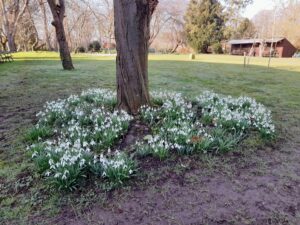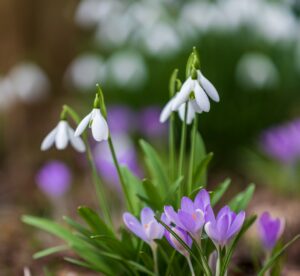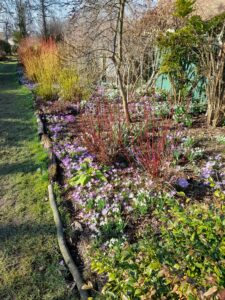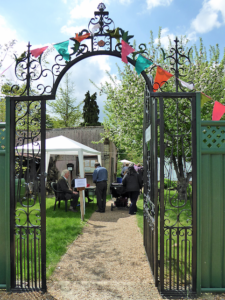 Spring is definitely in the air now, albeit with occasional wintery interludes, and we are looking forward to our first event of the year, the Children’s Easter Activity Morning from 10 am to 12 noon on Saturday 8th April. All the usual popular activities will be there for youngsters and old ’uns alike to enjoy: face-painting, pot-decorating, picture painting and an Easter-themed trail. Refreshments, as usual, served by MC Teas from the Challis House. We hope to see lots of families in the garden again on Easter Saturday. Spoiler alert: chocolate treats may be available!
Spring is definitely in the air now, albeit with occasional wintery interludes, and we are looking forward to our first event of the year, the Children’s Easter Activity Morning from 10 am to 12 noon on Saturday 8th April. All the usual popular activities will be there for youngsters and old ’uns alike to enjoy: face-painting, pot-decorating, picture painting and an Easter-themed trail. Refreshments, as usual, served by MC Teas from the Challis House. We hope to see lots of families in the garden again on Easter Saturday. Spoiler alert: chocolate treats may be available!
The garden team have been very busy in recent weeks preparing for the coming season. All the compost and leaf mould produced last year have been applied to the main herbaceous beds, vegetable plots and soft fruit. Seasonal pruning, tidying up, pond-weeding and annual tree work is well up to date. We can now concentrate on spring weeding, removing dead leaves and flower stems, installing plant supports, planting up the vegetable plots and fertilising trees and shrubs. As ever, plenty to do!
 The ever-increasing drifts of snowdrops, aconites and crocuses were especially good this year but cut short by cold spells in late February. Daffodils were the main highlight in March and should continue into April, followed by tulips, Crown Imperial lilies and bluebells in May. Winter- and spring-flowering shrubs added to the seasonal delights, some producing delicious fragrances: the best of these are shrub honeysuckles, Christmas box, Mahonia and Viburnum fragrans. As we move towards summer, we can look forward to some spectacular floral displays from flowering cherries, apple trees, horse chestnut, mock orange and laburnum.
The ever-increasing drifts of snowdrops, aconites and crocuses were especially good this year but cut short by cold spells in late February. Daffodils were the main highlight in March and should continue into April, followed by tulips, Crown Imperial lilies and bluebells in May. Winter- and spring-flowering shrubs added to the seasonal delights, some producing delicious fragrances: the best of these are shrub honeysuckles, Christmas box, Mahonia and Viburnum fragrans. As we move towards summer, we can look forward to some spectacular floral displays from flowering cherries, apple trees, horse chestnut, mock orange and laburnum.
The exceptionally cold spells this winter have caused considerable damage in the garden. Many of our favourite established shrubs have perished, most obviously Hebe, Hypericum (St John’s Wort) and myrtle. Viburnum tinus, Choisya and fuschias may recover but the extent of the damage is not yet clear. It also looks as if some of our most popular herbaceous perennials (penstemons, salvias and dahlias) have succumbed. Indoor plants in the vinehouse were particularly badly affected, especially the geraniums, cacti and succulents. In these circumstances, it is best not to cut back affected plants but allow time for them to recover before deciding whether to leave or replace them. We will strive to recover what we can, divide healthy clumps and source replacements, and also raise more bedding plants than usual to fill gaps. It may take a few seasons to fully recover the situation so the displays may not be as good as in recent years. Here’s hoping for kinder weather this year!
 Our museum and archives team are busy preparing the Challis Museum’s next exhibition – ‘Voices from the past. How did your street get its name?’
Our museum and archives team are busy preparing the Challis Museum’s next exhibition – ‘Voices from the past. How did your street get its name?’
Following on from the huge success of our ‘Platinum Jubilee’ exhibition last year, which attracted 684 visitors, we will be opening our new exhibition on Easter Monday 10th April from 10am to noon. The exhibition will then be open on Tuesdays and Saturdays from 10am to noon.
The exhibition will explore the origins of Sawston street names and prominent buildings named after local people (and some royals!) who have made a significant contribution to Sawston life. The streets covered will include:
Adeane Road, Ashley Way, Belbin Close, Bennet Way, Bircham House, Bowers Terrace, Burnand’s Place, Catley’s Walk, Challis Close, Crampton Terrace, Dockerill Close, Eccles Close, Edinburgh Avenue, Evans Way, Falkner Road, Gosling Way, Hammonds Road, Henry Morris Road, Huntingdon Road, Huddleston Way, Hurry’s Close, John’s Acre, Jones Place, Joyce’s Close, Kirkham Drive, Martindale Way, Mallow’s Close, Marven Centre, Marven Road, Milner Close, Morley’s Place, Pease Close, Princess Drive, Prince William Way, Queensway, Resbury Close, Roe’s Close, Spicer’s Field, Stanley Webb Close, Teversham Way, Uffen Way, Wakelin Avenue, Roughead Drive, Wards Close. You are in for some surprises!
Mike Redshaw



